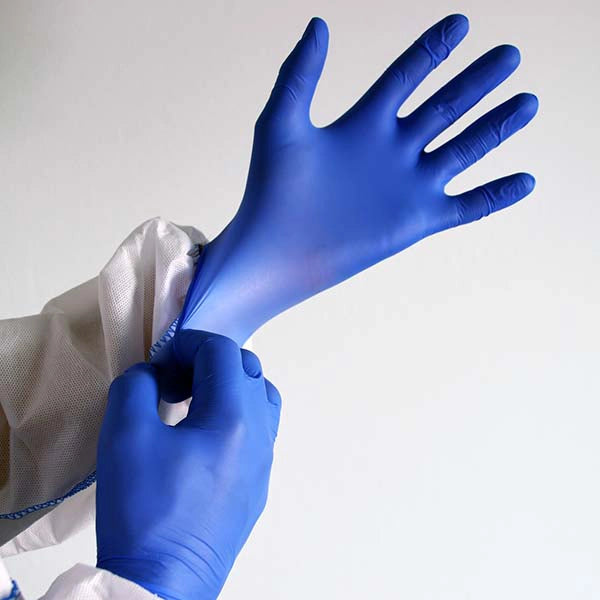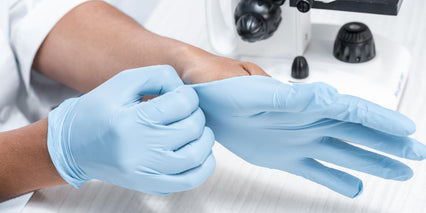Nitrile gloves are frequently used as an alternative to natural rubber latex gloves, but are these non-latex gloves better? Allergy to nitrile gloves symptoms are worth keeping in check.
Let’s find out whether or not nitrile gloves are truly a superior choice.
Can You Be Allergic to Nitrile Gloves?
Yes, some people are allergic to nitrile gloves. But it is not common to develop a skin allergy to nitrile. If you have intolerance to latex gloves, it is smart to watch for any symptoms you might develop from the chemical additives in nitrile gloves. Sensitive skin may especially be prone to irritations caused by these chemicals.
Can Nitrile Gloves Irritate Skin?
Some people experience skin irritation when wearing nitrile gloves. Nitrile rubber is a synthetic rubber used to produce latex-free gloves. People can become allergic to the chemicals added during the manufacturing of nitrile processes. Those with very sensitive skin may need to avoid wearing them at all times.
Are Nitrile Gloves Latex Free?
Do nitrile gloves have latex proteins? The latex proteins found in latex gloves are what cause many allergic reactions. Nitrile gloves do not contain latex proteins. An allergic reaction to the chemicals used to make the gloves will be milder and generally not life-threatening. Only 1% of people experience this problem.
What Causes Nitrile Allergy?
Some people develop a rash from nitrile gloves. Contact dermatitis is usually caused by an allergic reaction to the rubber accelerators used to manufacture nitrile gloves. These chemicals include thiurams, dithiocarbamates, and mercaptobenzothiazole. They may be the true cause of a red, itchy rash after wearing nitrile rubber gloves instead of a nitrile allergy.
What Are The Nitrile Glove Allergy Symptoms?
Hives
Itching and redness on the skin with white raised bumps are the most common first allergic reaction to nitrile gloves. If redness of hands occurs, wash your hands with soap and use hydrocortisone cream on the area.
Skin Rash
A rash from nitrile gloves will develop if the hives continue to spread. The rash may be accompanied by swelling of hands. If you develop a rash from gloves at work, this may be a clear indication. Seek medical care if this does not improve.
Cracked Skin
A more serious intolerance will cause the skin to crack. The cracked skin may burn and sting which could possibly lead to bleeding and infection if not treated properly. This results from prolonged exposure causing a typical reaction.
Other common symptoms include itching, burning sensation in hands, blisters, and sun sensitivity.
Irritant Contact Dermatitis
It is possible to have another type of reaction in the form of irritant contact dermatitis. Symptoms of this type of allergy include lesions, blisters, ulcers, and dry skin. Medical attention may be necessary if this occurs to prevent infection.
How To Treat Allergy To Nitrile Gloves?
If a reaction occurs, there are several ways to handle it. Nitrile gloves are often the best choice for those allergic to latex, but if irritation develops, they should be avoided. Washing the affected area with mild soap and water can help remove residual allergens.
Applying hydrocortisone cream can reduce inflammation and itching, and a doctor may prescribe stronger creams if needed. Oral antihistamines can also alleviate symptoms, but consult a healthcare provider before use. If symptoms persist or worsen, seek medical advice to confirm the allergy and get further treatment recommendations.
To prevent future reactions, consider switching to hypoallergenic gloves and using glove liners for added protection. Maintaining good hand hygiene is also crucial in managing and preventing allergic reactions.
What is Allergic Contact Dermatitis?
Allergic contact dermatitis is an allergic skin reaction similar to eczema that forms after direct contact with the skin. This is the most common type of simple skin irritation for a variety of occupations requiring gloves.
What is the Purpose of the Chemical Additives?
The accelerators or additive chemicals are used as a catalyst to accelerate the process of turning latex from a liquid to a gel. They are also used for added elasticity and durability.
Do Nitrile Gloves Contain Thiuram?
Yes! Over 50% of contact dermatitis on the hands and wrist are caused by thiuram. This chemical used in the production of gloves is the leading cause of most problems that appear.
Who is Prone to a Synthetic Gloves Reaction?
Healthcare workers, hairdressers, mechanics, and cafeteria workers with a latex allergy who choose a latex-free option instead are all prone to irritation. Dry skin, sweating, friction, and repetitive washing may accelerate the annoyance further.
Prevention of Nitrile Glove Allergy
The risk of an allergic reaction to nitrile gloves can be reduced if proper care is taken when wearing gloves. At the first sign of irritation, take the gloves off immediately and wash your hands with soap and water. Use vinyl gloves in the meantime to see if the problem clears up completely.
Do not wear the gloves for too long. Nitrile gloves, like other types of gloves, can chafe the skin and cause irritation if they are worn longer than necessary. The best way to prevent nitrile allergy reactions is to avoid wearing them.
Can I Skip Wearing Gloves?
Some people will choose to avoid wearing any and all types of gloves, but this can increase risk of infections. Because the skin is not covered when working with unprotected hands, there is a greater risk of bacteria entering the body and causing sickness or disease.
This is why most choose to wear some sort of gloves in order to protect their hands from infections that could occur. Nitrile gloves are a viable option if they cause no allergic reactions. Most people who use them on a regular basis do not complain about itching or redness of the skin.
What Can I Use Instead of Nitrile Gloves?
There are many other glove options available for use in places where nitrile gloves are required, but those who believe they have reactions to nitrile may want to try out other products. Disposable nitrile accelerator-free gloves are worth trying!
Vinyl gloves are also a good alternative. This type of glove will provide some protection against common infections for those who work in conditions where they are likely to come into contact with bacteria and other pathogens. They can be worn underneath nitrile gloves to ensure maximum protection from allergens.
Nitrile and Natural Latex Risk Factors
While there is a chance that a person could be allergic to any type of glove, it seems that most people have problems with nitrile and latex gloves. These are the most common types of medical gloves used in hospitals and by health care workers, but problems can arise with each one.
It is important to remember that even if a person does not think they are allergic to disposable gloves, they should be careful when wearing them.
Why gloves.com is the Best Choice for Buying Gloves
When it comes to finding the best gloves to avoid allergies and ensure comfort, gloves.com stands out as the premier choice. They offer a wide selection of hypoallergenic gloves, including nitrile, vinyl, and other latex-free options, to suit various needs and preferences.
Additionally, with a 50% discount on orders, Gloves.com provides both quality and affordability, making it the perfect place to purchase gloves for those with sensitive skin or latex allergies. Visit gloves.com today to explore their extensive range and take advantage of their unbeatable deals.
Allergy To Nitrile Gloves: Frequently Asked Questions
Why do I get a rash on my hands after wearing nitrile gloves?
A rash on your hands after wearing nitrile gloves could be due to contact dermatitis or a sensitivity to the chemicals used in the manufacturing process of the gloves. This reaction can occur from prolonged exposure to the gloves, sweat accumulation, or a specific chemical component. If you experience a rash, it’s important to stop using the gloves and consult with a healthcare provider to determine the exact cause and appropriate treatment.
Are nitrile gloves OK for sensitive skin?
Nitrile gloves are generally considered a good option for individuals with sensitive skin, as they are less likely to cause allergic reactions compared to latex gloves. They are made from synthetic rubber and are free from latex proteins, which are common allergens. However, if you have very sensitive skin, it’s a good idea to test a small area first or consult with a dermatologist to ensure they are suitable for you.
What type of gloves are most people allergic to?
Most people who experience glove allergies are allergic to latex gloves. Latex allergies are caused by proteins found in natural rubber latex, which can trigger reactions ranging from mild skin irritation to severe anaphylactic responses. Because of this, many healthcare facilities and other industries have moved to using alternatives like nitrile or vinyl gloves.
What does glove allergy look like?
A glove allergy typically presents as contact dermatitis, which includes symptoms such as redness, itching, and swelling of the skin where the gloves were in contact. In more severe cases, it can cause hives, blisters, or even respiratory symptoms if the allergy is triggered by inhalation of glove powder containing latex proteins. If you suspect a glove allergy, it’s important to discontinue use and seek medical advice for proper diagnosis and treatment.





